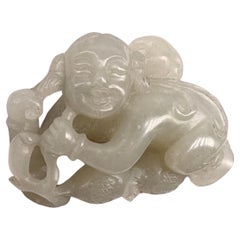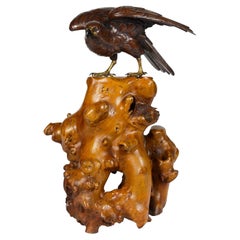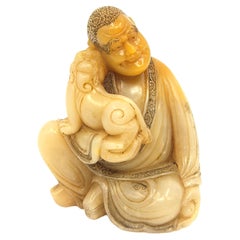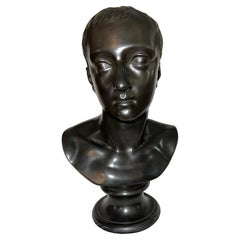Late 19th Century Sculptures and Carvings
Antique Late 19th Century Sculptures and Carvings
Jade
Japanese Napoleon III Antique Late 19th Century Sculptures and Carvings
Wood
Japanese Antique Late 19th Century Sculptures and Carvings
Bronze
Chinese Qing Antique Late 19th Century Sculptures and Carvings
Stone
Japanese Antique Late 19th Century Sculptures and Carvings
Bronze
Antique Late 19th Century Sculptures and Carvings
Stoneware
Chinese Antique Late 19th Century Sculptures and Carvings
Agate, Carnelian
Japanese Meiji Antique Late 19th Century Sculptures and Carvings
Wood
Japanese Meiji Antique Late 19th Century Sculptures and Carvings
Wood, Paint
East Asian Folk Art Antique Late 19th Century Sculptures and Carvings
Hardwood, Paint
Chinese Qing Antique Late 19th Century Sculptures and Carvings
Cypress
French Antique Late 19th Century Sculptures and Carvings
Bronze
Chinese Victorian Antique Late 19th Century Sculptures and Carvings
Sterling Silver
Bhutanese Tibetan Antique Late 19th Century Sculptures and Carvings
Bronze
Chinese Qing Antique Late 19th Century Sculptures and Carvings
Wood, Ivory
Burmese Other Antique Late 19th Century Sculptures and Carvings
Belgian Black Marble, Bronze
Burmese Antique Late 19th Century Sculptures and Carvings
Marble
Indian Folk Art Antique Late 19th Century Sculptures and Carvings
Wood
Japanese Edo Antique Late 19th Century Sculptures and Carvings
Cedar
Chinese Qing Antique Late 19th Century Sculptures and Carvings
Stone, Jade
Chinese Antique Late 19th Century Sculptures and Carvings
Wood
Japanese Folk Art Antique Late 19th Century Sculptures and Carvings
Iron
Japanese Meiji Antique Late 19th Century Sculptures and Carvings
Wood
Japanese Meiji Antique Late 19th Century Sculptures and Carvings
Wood
Chinese Antique Late 19th Century Sculptures and Carvings
Porcelain
Japanese Edo Antique Late 19th Century Sculptures and Carvings
Cedar
Japanese Antique Late 19th Century Sculptures and Carvings
Wood
Japanese Meiji Antique Late 19th Century Sculptures and Carvings
Bone, Hardwood
Japanese Meiji Antique Late 19th Century Sculptures and Carvings
Cedar
Japanese Meiji Antique Late 19th Century Sculptures and Carvings
Iron
Japanese Meiji Antique Late 19th Century Sculptures and Carvings
Bronze
Chinese Qing Antique Late 19th Century Sculptures and Carvings
Wood
Chinese Chinese Export Antique Late 19th Century Sculptures and Carvings
Stone
Japanese Edo Antique Late 19th Century Sculptures and Carvings
Boxwood
Chinese Antique Late 19th Century Sculptures and Carvings
Wood
Japanese Meiji Antique Late 19th Century Sculptures and Carvings
Boxwood, Lacquer
Tibetan Antique Late 19th Century Sculptures and Carvings
Wood, Lacquer, Paint
Chinese Chinese Export Antique Late 19th Century Sculptures and Carvings
Stone
Japanese Meiji Antique Late 19th Century Sculptures and Carvings
Cedar
Japanese Meiji Antique Late 19th Century Sculptures and Carvings
Cedar
Japanese Meiji Antique Late 19th Century Sculptures and Carvings
Wood
Japanese Meiji Antique Late 19th Century Sculptures and Carvings
Wood, Cedar
Japanese Antique Late 19th Century Sculptures and Carvings
Wood
Chinese Chinese Export Antique Late 19th Century Sculptures and Carvings
Clay
Chinese Chinese Export Antique Late 19th Century Sculptures and Carvings
Wood, Elm
Chinese Chinese Export Antique Late 19th Century Sculptures and Carvings
Jade
Burmese Antique Late 19th Century Sculptures and Carvings
Wood
Nepalese Antique Late 19th Century Sculptures and Carvings
Bronze
Asian Tibetan Antique Late 19th Century Sculptures and Carvings
Metal
Japanese Meiji Antique Late 19th Century Sculptures and Carvings
Wood
Burmese Antique Late 19th Century Sculptures and Carvings
Wood
Burmese Antique Late 19th Century Sculptures and Carvings
Bronze
Burmese Antique Late 19th Century Sculptures and Carvings
Bronze
Burmese Antique Late 19th Century Sculptures and Carvings
Wood
Thai Antique Late 19th Century Sculptures and Carvings
Teak
Burmese Antique Late 19th Century Sculptures and Carvings
Wood
Nepalese Antique Late 19th Century Sculptures and Carvings
Bronze
Antique Late 19th Century Sculptures and Carvings
Horn
Read More
12 Calming Spaces Inspired by Japanese Design
From cherry-blossom-adorned walls paired with glamorous lighting to wood-paneled ceilings above checkerboard-patterned chairs, these 12 spaces seamlessly blend Eastern and Western aesthetics.
Rodrigo Rivero Lake’s Mexico City Showroom Is a Museum-Worthy Trove of Spanish Colonial and Asian Antiques
The dealer and curator has spent the past 50 years amassing a collection of exceptional art, furniture and architectural elements that trace the cultural influence of the Spanish empire from Europe to the Americas and beyond.




